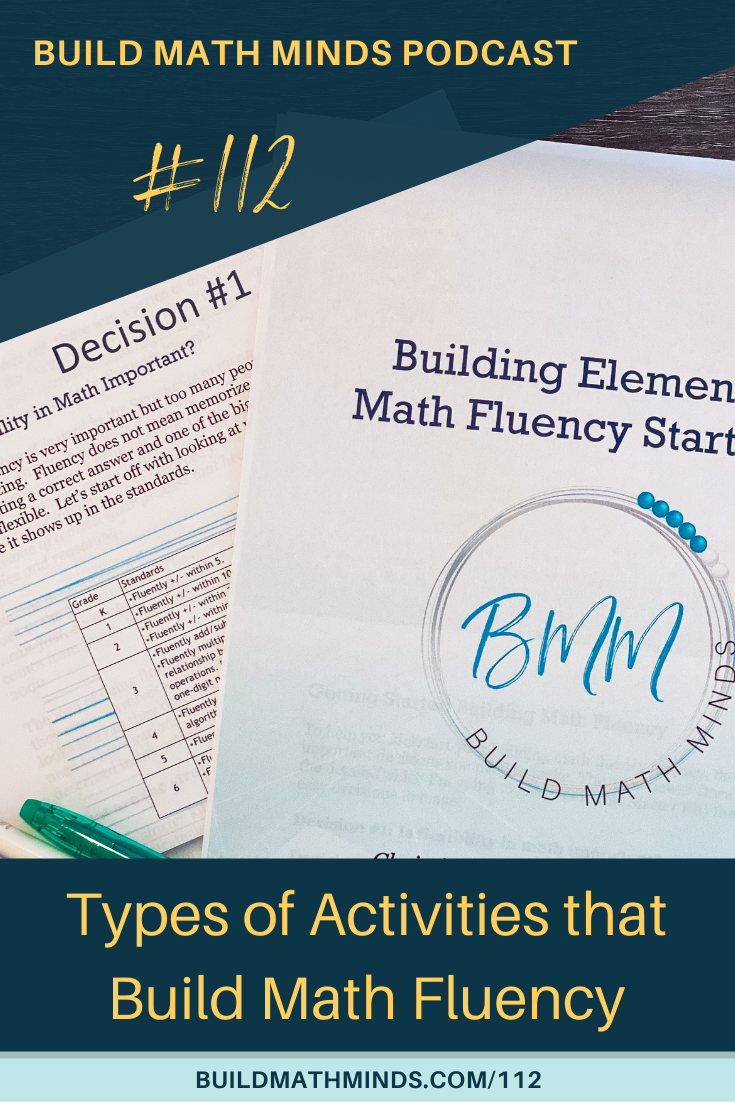Resources mentioned in this episode:
Get the Building Elementary Math Fluency Starter Kit
The Flexibility Formula courses (if registration is not open, you can join the waitlist)
Welcome fellow Recovering Traditionalists to Episode 112. Today we are taking a look at the Types of Activities that Build Math Fluency.
Last week I shared an excerpt from the Building Elementary Math Fluency Starter Kit I created to help elementary educators get started down the journey of building fluency by focusing on building students’ flexibility. I’d like to share a little bit more from that starter kit with you today. If you’d like to get the starter kit go to BuildMathMinds.com/starterkit.
On pages 31-32, I write:
“The final step towards building your students’ fluency is deciding HOW you are going to implement these ideas into your classroom. I am not going to detail out exactly how you should do that. That’s not what I believe we should do for teachers just like I don’t believe that’s what we should do for our students in math. We should NOT make everyone do it the same way. Every classroom is filled with kids of varying needs and abilities. Every classroom has a teacher with their own teaching style. So what works for one classroom will not always work for everyone else. I understand that having some kind of guideline is important.
Everyone’s situations are different. You may be tied to a textbook or you might be in a district that doesn’t use a textbook and the standards are your only guide. No matter your situation there are three types of activities I recommend trying to incorporate as much as you can.
- Number Sense Routine
- Story Problems
- Games
We go into more ideas and detail in my Flexibility Formula course on all three of these but… It’s all about meeting your students where they are right now. What areas of number sense do your kids need to develop? How can you craft story problems that highlight your students and their interests? What games can you use to help give kids practice and repetition?
These are all questions that have answers specific to you, your students, their culture & community, your teaching style, and your students’ learning styles. I’m not going to tell you to use a game that uses tons of dice and gets kids excited and hollering during the game. Because not every teacher can handle that. If the make-up of the activity drives you crazy you will never use it.
So we will end this starter kit with where you start. I want you to start by thinking about how much time you’ve spent focusing on building fluency…true fluency…not just helping kids get fast & accurate, but their flexibility as well. Remember, we’ve all been there. We’ve all taught kids just to be quick and correct. But as we learn better we do better. Don’t spend time thinking about all the ways you’ve taught math wrong in the past, focus on how you can change for the kids in the future.
There is so much we could do, but as you start to think about ways to adapt the lessons you’ve done in the past I want you to focus on those three types of activities to provide your students: Number Sense, Story Problems, and Games. Maybe you only pick one of those to focus on for right now. Maybe you are able to do all three. Do what works for you, just like I’ve recommended in this kit for you to do for your students.”
The rest of the kit then links up some of my favorite resources to help you implement the ideas. I give you resources for building Number Sense, doing Story Problems, and implementing Games in your classroom. When you get the starter kit, I also email you links to a video series I did about building true math fluency. What it is, how to do it, and in that video series I give you more information about the 3 types of math activities that build fluency and why they are so important to implement into your classroom.
If you’d like to get started building your students’ flexibility and their fluency, go get the Building Elementary Math Fluency Starter Kit at BuildMathMinds.com/starterkit and I’ll send you the free kit and the links to the fluency video series.
Subscribe and Review in iTunes
Hey, are you subscribed to the Build Math Minds Podcast, yet? If you’re not, make sure to do that today because I don’t want you to miss any episodes! Click here to subscribe to the podcast in iTunes.
While you’re there, don’t forget to leave a review on iTunes too. I would love to know your thoughts and how we can make sure that we give you content that you will really enjoy.
To leave a review, head over to iTunes and click on “Ratings and Reviews” and “Write a Review.” I can’t wait to hear your thoughts about the podcast.




